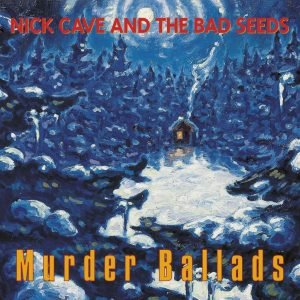Released in 1996, Murder Ballads stands as a macabre yet fascinating entry in Nick Cave and the Bad Seeds’ discography. Coming after 1994’s Let Love In, which itself brooded over themes of love, violence, and spirituality, Murder Ballads takes Cave’s signature gothic storytelling to its darkest extreme. With this album, Cave immerses himself fully in the folk tradition of murder ballads, songs that have long recounted tales of crime, death, and punishment. However, he does so with a modern, almost cinematic flair that fuses his fascination with mythology, brutality, and poetic lyricism.
Artistic Intentions
In terms of the broader music landscape, Murder Ballads was a bold and unconventional move, particularly as the ’90s was dominated by alternative rock, grunge, and burgeoning electronic sounds. The album’s fixation on archaic storytelling forms set it apart from much of what was popular at the time, reflecting Cave’s commitment to challenging both his listeners and himself as a songwriter. Rather than follow the commercial trends, Cave leaned into his artistic persona as a dark balladeer, turning this record into a deeply atmospheric, almost theatrical experience.
Cave’s artistic intentions with Murder Ballads seem clear: to explore the intersection of violence and beauty, and to examine how narratives of death and destruction could be woven into a kind of twisted, gothic morality play. In interviews, Cave has often noted his attraction to the primal themes of these traditional songs—the way they strip human nature down to its barest impulses. He doesn’t just retell folk stories here; instead, he injects them with a sense of grandeur and grotesque humor. This is an album meant to provoke discomfort, fascination, and even a kind of bleak amusement, all while reveling in the rawness of human nature.
Sonic Exploration

The production of Murder Ballads is as evocative as its subject matter. Handled by longtime Bad Seeds collaborator Tony Cohen, the album possesses a meticulous, almost cinematic quality, blending lush orchestration with gritty, atmospheric textures. While not pristine in the sense of modern digital clarity, the production is rich in its layering and deliberately unpolished in moments, capturing the raw emotion and intensity of the album’s violent tales. The mix is often dense, with swirling violins, moody piano lines, and Cave’s deep, rumbling voice anchoring the chaos, creating an immersive soundscape that feels both sinister and grand. This balance between elegance and disorder mirrors the album’s thematic tension between beauty and brutality, amplifying the emotional impact of each track.
Musical Arrangements
The musical arrangements on Murder Ballads are perhaps one of its most striking features. The Bad Seeds, with their ever-eclectic lineup, orchestrate a sonic tapestry that moves seamlessly between folk, blues, and rock, with moments of dark cabaret. Strings and piano often lead the way, but there’s an unpredictability to the instrumentation that keeps listeners on edge.
On “Stagger Lee,” for instance, the song’s skeletal blues riff gives way to discordant bursts of guitar and a guttural vocal performance from Cave, amplifying the grotesque violence of the lyrics. In contrast, “Where the Wild Roses Grow” offers a mournful duet with Kylie Minogue, framed by gentle strings and hushed percussion, creating an eerie juxtaposition between the sweetness of the arrangement and the grim murder at the heart of the song.
Vocally, Cave shifts between narrator and character, often embodying the murderers in his stories with terrifying conviction. The guest vocalists, particularly Minogue and PJ Harvey on “Henry Lee,” add haunting layers to the album, playing the role of victims or tragic lovers, and the interplay of voices gives the record a more theatrical and immersive quality.
Genre Elements
Genre-wise, Murder Ballads is a melting pot of styles. It draws heavily from traditional folk and blues, as is typical for the murder ballad genre, but these elements are warped and stretched through Cave’s unique gothic lens. There’s a distinct punk energy that seeps through, especially in the aggressive and snarling delivery of “Stagger Lee,” while the orchestral flourishes and brooding piano balladry give the album a noir-like sophistication. At its core, Murder Ballads is a gothic-folk record, but it ventures boldly into rock, blues, and even classical, blurring the lines between traditional and experimental music. This genre-blending only heightens the sense of unpredictability, keeping the listener constantly shifting between emotions—fear, awe, and even dark amusement.
Lyrical Analysis

Thematically, Murder Ballads delves into the darkest corners of the human psyche, exploring violence, death, and desire with unflinching honesty. Nick Cave taps into the folk tradition of murder ballads to tell stories of brutality, betrayal, and fatal love, but these songs aren’t mere retellings of old folk tales—they are infused with Cave’s characteristic blend of gothic romanticism and grim humor. Throughout the album, Cave investigates not only the act of murder but also the emotions that surround it: lust, jealousy, revenge, and remorse. Each song is a self-contained narrative, but together they form a cohesive exploration of human nature at its most primal.
Recurring motifs of blood, flowers, and water (as a symbol of death or purification) run through the album, linking the songs thematically. In “Where the Wild Roses Grow,” the rose symbolizes both beauty and death, while in “The Curse of Millhaven,” water is used to symbolize both the literal and metaphorical drowning of innocence. This imagery reinforces the contrast between the grotesque and the beautiful, a duality that runs through the entire record.
Lyrical Depth
Lyrically, Murder Ballads is one of Cave’s most narratively focused albums. The stories are vivid, often graphic, with a sense of dark irony that makes even the most disturbing scenes feel strangely poetic. On tracks like “Stagger Lee,” the lyrics are raw and brutal, recounting a tale of murder and dominance in gritty, explicit detail: “He said, ‘Mr. Motherf***er, you know who I am’ / And the barkeeper said, ‘No, and I don’t give a good goddamn.’” This confrontation of violence, told with relish, is typical of the album’s most savage moments.
Yet in contrast, “Where the Wild Roses Grow” reads like a tragic love ballad, with lyrical simplicity that belies the horror of the act it recounts. The interplay of voices between Cave and Kylie Minogue turns the song into a haunting dialogue between the murderer and his victim, layering the narrative with both sorrow and cold calculation.
Cave’s lyrics can be straightforward in their storytelling—many of the songs read like short stories, each with a beginning, middle, and end. However, there’s a deeper complexity beneath the surface, particularly in how Cave plays with perspective and morality. “The Kindness of Strangers” is narrated from a detached observer’s point of view, which creates an eerie distance from the tragic events, leaving listeners to question their own role as passive witnesses to these horrors. In songs like “Lovely Creature” and “Song of Joy,” the ambiguity in the narrator’s tone and motives adds layers of tension and mystery, making the listener unsure of whom to trust or sympathize with.
Emotional Impact
Emotionally, the album’s lyrics are visceral, capable of evoking a range of responses. There’s a kind of grotesque fascination in songs like “Stagger Lee,” where the excesses of violence and depravity become almost absurdly entertaining, daring the listener to find humor in the horror. In contrast, tracks like “Henry Lee” and “Where the Wild Roses Grow” evoke deep melancholy, as the inevitability of death is woven into these tragic love stories.
Cave doesn’t simply recount these murders—he makes them feel personal, inviting the listener into the mindset of both the victim and the perpetrator. The result is a mix of empathy, revulsion, and reflection on the darker aspects of desire and human nature. In its most reflective moments, the album forces listeners to confront their own capacity for violence and the thin line between love and destruction.
Cohesion and Flow

Murder Ballads unfolds with a grim and deliberate sense of cohesion, both thematically and musically. The album’s tracks are linked by a consistent focus on violent narratives, each song presenting a new tale of murder, yet they also build on one another in terms of emotional intensity and thematic depth. There’s an almost cinematic progression to the album’s structure, where each track feels like a new chapter in a larger, blood-soaked storybook. While every song stands alone as a unique narrative, the sequencing creates a broader emotional arc, leading the listener from one haunting tale to another, deepening the immersion into Nick Cave’s dark world.
Track Progression
The album begins with “Song of Joy,” a slow-burning, foreboding introduction that sets the tone for what’s to come. Cave’s narrator recounts a tale of loss and death with eerie detachment, immediately drawing the listener into the album’s world of murder and mystery. From there, the album’s intensity fluctuates but always maintains its thematic focus. Tracks like “Stagger Lee” ramp up the violence and aggression, while “Henry Lee” and “Where the Wild Roses Grow” inject moments of tragic beauty and sorrow into the progression. The placement of these songs feels deliberate—after the brutal swagger of “Stagger Lee,” for example, “Henry Lee” provides a quieter, more mournful counterbalance, preventing the album from feeling monotonous or overwhelming in its darkness.
The pacing of the album is also well-considered. The midsection, with songs like “Lovely Creature” and “The Kindness of Strangers,” serves as a reflective pause, where the narratives slow down and focus more on atmosphere and emotional tension than on outright violence. This allows the album to breathe and gives the listener space to process the intensity of the previous tracks.
By the time the frenetic energy of “The Curse of Millhaven” arrives, a manic tale of mass murder told from the perspective of a disturbingly gleeful young girl, the album’s emotional stakes have reached a fever pitch. This climactic moment is then followed by the hauntingly somber closer, “Death is Not the End,” which feels like a dark lullaby—a reminder of the album’s cyclical theme of death and its inescapable presence in every story.
Thematic Consistency
Thematically, Murder Ballads is remarkably consistent. Every track centers around murder in some form, whether it’s a crime of passion, vengeance, or simply senseless violence. The styles of storytelling vary—some songs are direct and brutal, while others are more poetic or ambiguous—but the overarching themes of death, violence, and the consequences of human desire remain steadfast throughout. Even with the tonal shifts between aggressive songs like “Stagger Lee” and the melancholic duets like “Henry Lee,” the album never feels disjointed. Each track reinforces the central idea of exploring the darker sides of human nature through murder, which binds the album together as a cohesive whole.
Musically, the flow of styles—ranging from bluesy swagger to melancholic balladry—keeps the album engaging, yet never strays so far as to break the thematic consistency. The instrumentation and production create a sonic landscape that feels both timeless and unsettling, a perfect backdrop for the tales Cave is telling. The shifts in mood, from the grim humor of “Stagger Lee” to the tragic tenderness of “Where the Wild Roses Grow,” feel natural rather than jarring. Cave and the Bad Seeds maintain a gothic, noir-like atmosphere that threads through every track, ensuring that even the album’s most diverse moments contribute to its overall sense of cohesion.
Standout Tracks and Moments
Several tracks on Murder Ballads stand out as high-water marks in Nick Cave and the Bad Seeds’ already impressive repertoire, each one representing different facets of the album’s artistic vision. These songs exemplify the album’s darkly poetic storytelling, inventive musical arrangements, and emotional depth, making them integral to understanding its overall impact.
“Where the Wild Roses Grow” (feat. Kylie Minogue)
Perhaps the most commercially successful song on the album, “Where the Wild Roses Grow” is a haunting duet that juxtaposes beauty and violence with chilling grace. Featuring pop icon Kylie Minogue in an unexpected but stunning collaboration, the track tells the story of a doomed love affair ending in murder. Minogue’s ethereal vocals, playing the innocent victim Eliza Day, contrast sharply with Cave’s deeper, menacing tone as the narrator. The song’s slow, mournful string arrangement and delicate piano underscore the inevitability of Eliza’s fate, making the moment Cave sings the line “All beauty must die” all the more devastating. This blend of elegance and horror captures the album’s central themes perfectly, making it one of Murder Ballads’ most unforgettable tracks.
“Stagger Lee”
“Stagger Lee” is a brutal, swaggering centerpiece of the album, and one of its most memorable moments. Based on the traditional American folk song, Cave’s version is a twisted, hyper-violent take that drips with menace and dark humor. His guttural, sneering delivery of the lyrics, accompanied by a sparse, bluesy rhythm, makes the song feel almost like a musical showdown.
The escalating violence in the lyrics is punctuated by the band’s explosive instrumental flourishes, creating a visceral sense of danger. Lines like “I’m a bad motherf***er, don’t you know / And I’ll crawl over fifty good pussies just to get to one fat boy’s asshole” shock with their audacity and graphic nature, making this track stand out for its sheer intensity and defiance of traditional folk storytelling norms.
“Henry Lee” (feat. PJ Harvey)
Another standout duet, “Henry Lee” pairs Nick Cave with PJ Harvey in a tragic tale of passion and betrayal. Unlike “Stagger Lee,” this song’s violence is more subtle, almost tender, as Harvey’s character lures Henry Lee to his death out of unrequited love. The song’s minimalist arrangement—driven by a hypnotic, repeating string motif—draws focus to the two vocalists. Cave and Harvey’s chemistry is palpable, and their voices intertwine in a way that adds both intimacy and tension to the narrative. The final verse, where Harvey’s soft voice delivers the fatal blow, is both chilling and poignant, marking this as one of the album’s most emotionally affecting moments.
“The Curse of Millhaven”
One of the most manic and darkly humorous tracks on the album, “The Curse of Millhaven” is a standout for its sheer energy and vivid storytelling. Told from the perspective of a teenage girl named Loretta who gleefully admits to being a serial killer, the song’s galloping rhythm and frenzied delivery mirror the unhinged mindset of its narrator. The fast-paced lyrics paint an absurdly graphic picture of the carnage she’s caused in her small town, with lines like, “I’ve strangled pets and I’ve set fire to the neighbors’ house.” Cave’s exaggerated vocal delivery and the Bad Seeds’ rollicking instrumental backdrop make this song both horrifying and strangely exhilarating, demonstrating his knack for blending humor with horror.
Memorable Moments
The Silence in “Where the Wild Roses Grow”
One of the most powerful moments in the album comes not from a lyric or instrumental flourish, but from the brief silence that follows Cave’s declaration, “All beauty must die,” in “Where the Wild Roses Grow.” This momentary pause is a chilling reflection of Eliza’s sudden, tragic end, and the emptiness that follows her death. It’s a subtle yet masterful use of silence, allowing the emotional weight of the song to hang in the air before the final refrain.
Cave’s Sneer in “Stagger Lee”
The performance of Nick Cave on “Stagger Lee” is a standout vocal moment in his entire career. His snarling, sneering delivery of each line feels almost theatrical, as if he’s embodying the character of Stagger Lee with every breath. The way he stretches and growls through phrases like “I’m a bad motherf***er” adds layers of menace and dark humor, turning the song into a menacing, unforgettable tale of outlaw swagger.
The Duet Dynamics in “Henry Lee”
In “Henry Lee,” it’s the vocal interplay between Nick Cave and PJ Harvey that makes the song so memorable. Their contrasting vocal tones—Cave’s deep and resonant, Harvey’s delicate but sharp—create a palpable tension that drives the song toward its inevitable conclusion. The subtle shift in Harvey’s delivery when she reveals her murderous intentions brings a new depth to the song, making her betrayal feel both haunting and intimate.
The Frenzied Climax of “The Curse of Millhaven”
Toward the end of “The Curse of Millhaven,” as the pace quickens and Cave’s delivery becomes increasingly frantic, there’s a moment where the song reaches an almost feverish pitch. The madness of Loretta’s killings culminates in this burst of energy, perfectly mirroring the chaos of the narrative. It’s a whirlwind of sound and storytelling that captures the album’s essence—grotesque, theatrical, and thrilling.
Artistic Contribution and Innovation

Within the landscape of alternative music, Murder Ballads stands as a daring and genre-defying work, cementing Nick Cave and the Bad Seeds’ reputation as boundary-pushing artists. Released in 1996, a time when the music industry was dominated by grunge, Britpop, and emerging electronic genres, Murder Ballads veered in an entirely different direction. Rather than following the prevailing trends of the era, Cave chose to delve deeper into gothic folk traditions and archaic storytelling, creating an album that felt both timeless and subversive. This decision to center an entire record around the macabre and often gruesome subject matter of murder ballads marked a significant departure from mainstream norms and pushed the boundaries of what was considered acceptable in popular music.
Place in Genre/Industry
Murder Ballads defies easy categorization. At its core, it draws from the folk and blues traditions of murder ballads, but Cave transforms these influences into something far more expansive and eclectic. By fusing elements of folk, gothic rock, punk, and blues with his own unique brand of dark romanticism, Cave reinvigorated a nearly forgotten tradition and introduced it to a contemporary audience. In the context of the ‘90s alternative scene, the album felt like a bold rejection of commercial trends in favor of deep, literary storytelling and uncompromising artistic vision. Its willingness to dwell on the darker aspects of human nature, combined with its theatrical flair, set it apart from more straightforward rock or folk releases.
Moreover, Murder Ballads demonstrated that Cave was not simply a songwriter or a bandleader but a narrative craftsman, one who could take established folk forms and twist them into modern, provocative statements. The album’s success showed that there was still room in the industry for albums that were challenging, literary, and conceptually unified, pushing back against the more fragmented, single-driven model that was becoming the norm.
Innovation
One of the most innovative aspects of Murder Ballads is its thematic commitment. Concept albums had been done before, but few had pursued such a singularly dark and violent theme so thoroughly, and with such an unflinching eye for detail. By building the entire album around murder narratives, Cave takes the traditional murder ballad to new heights, blending folklore with contemporary sensibilities, and crafting a full-length work that feels cohesive both musically and thematically.
This approach not only revitalized the murder ballad tradition but also injected it with a new sense of relevance, proving that age-old stories of violence and death could still resonate with modern audiences. Cave’s willingness to push lyrical boundaries—often blending grotesque violence with a kind of dark humor—was also innovative, daring listeners to confront the discomforting and often absurd aspects of human nature.
Production
From a production standpoint, Murder Ballads also pushes the envelope. The lush yet unsettling production, spearheaded by Tony Cohen, seamlessly blends elegance with grit, creating soundscapes that feel both haunting and beautiful. The arrangements are innovative in their use of space and contrast—mixing sparse, minimalist instrumentation with grandiose, orchestral elements to evoke tension and release. Songs like “Where the Wild Roses Grow” and “Stagger Lee” exemplify this balance: the former is a hauntingly delicate duet that builds an atmosphere of eerie calm, while the latter is raw, confrontational, and laced with a sense of danger. These contrasts between the refined and the visceral are a hallmark of Cave’s work, but they are executed with particular finesse on this album.
Collaborations
Additionally, Cave’s use of collaboration on Murder Ballads—particularly with high-profile artists like Kylie Minogue and PJ Harvey—was an inspired and unexpected move. Minogue, known for her pop career, was an unlikely choice for a dark ballad about murder, but this contrast only amplified the song’s impact. By bringing together artists from different musical backgrounds, Cave broadened the album’s reach and added new textures to his storytelling. This juxtaposition of genres, styles, and voices was innovative, expanding the murder ballad genre beyond its traditional folk roots and pulling it into new territory.
Storytelling
In terms of storytelling, Cave doesn’t just retell traditional murder ballads; he adds a modern sensibility to the narratives, incorporating psychological complexity and moral ambiguity. The characters in Murder Ballads are not mere caricatures of evil or victims—they’re fully realized figures, often tragic and flawed, and their stories are told with a mix of empathy, horror, and sometimes dark humor. This narrative depth, paired with Cave’s lyrical prowess, takes the murder ballad form to new artistic heights.
Closing Thoughts

Murder Ballads is a daring and unapologetically macabre exploration of violence, death, and desire, showcasing Nick Cave at the height of his storytelling prowess. The album’s strengths lie in its thematic unity, masterful lyricism, and innovative blending of genres. From the hauntingly beautiful “Where the Wild Roses Grow” to the visceral menace of “Stagger Lee,” each track offers a unique perspective on the human capacity for brutality, all set against a backdrop of gorgeously dark instrumentation. Cave’s ability to create fully realized narratives in each song, paired with the Bad Seeds’ lush, immersive arrangements, makes Murder Ballads a deeply engaging and immersive listen.
Strengths & Weaknesses
One of the album’s greatest achievements is its ability to evoke a wide range of emotions—fear, sorrow, empathy, and even grim amusement. The interplay of elegance and rawness, humor and horror, makes it a complex, multi-layered work that demands the listener’s full attention. The collaborations with Kylie Minogue and PJ Harvey add a dynamic dimension to the album, further enhancing its theatrical and emotional depth.
However, Murder Ballads is not without its challenges. Its intense focus on murder, violence, and dark themes may alienate some listeners, and the graphic nature of songs like “Stagger Lee” can be shocking or off-putting. This is an album that doesn’t shy away from uncomfortable territory, and as such, it may not have the broad appeal of some of Cave’s other works. For those willing to confront its grim subject matter, however, the album offers an incredibly rewarding experience.
In the context of Nick Cave’s career, Murder Ballads represents a pivotal moment where he fully embraces his role as a modern-day storyteller, taking the murder ballad tradition and transforming it into something both timeless and innovative. It’s an album that stands apart from the musical trends of its time and has left a lasting impact on both Cave’s discography and the broader alternative music scene.
Official Rating
The decision to give Murder Ballads a 9/10 stems from its bold artistic vision, lyrical brilliance, and its seamless execution of a deeply unified thematic concept. It’s a near-perfect album for what it sets out to achieve, offering a haunting and immersive experience. While its challenging content might not be for everyone, it’s hard to deny the sheer mastery with which Nick Cave and the Bad Seeds craft these tales of blood and beauty. The only reason it doesn’t reach a full 10/10 is because its niche subject matter could limit its accessibility, but for those attuned to its dark beauty, it’s nothing short of a masterpiece.
